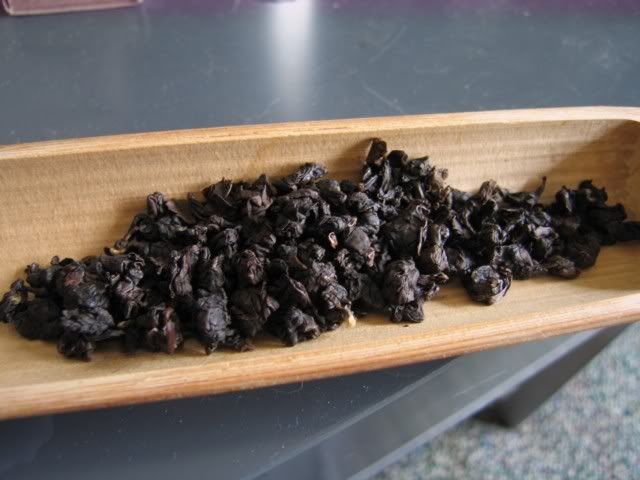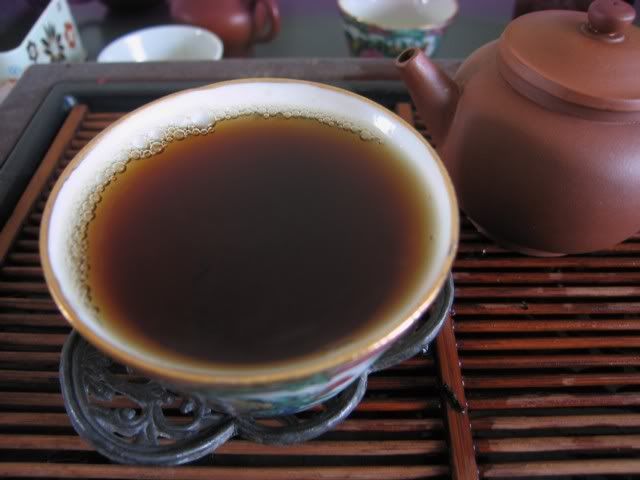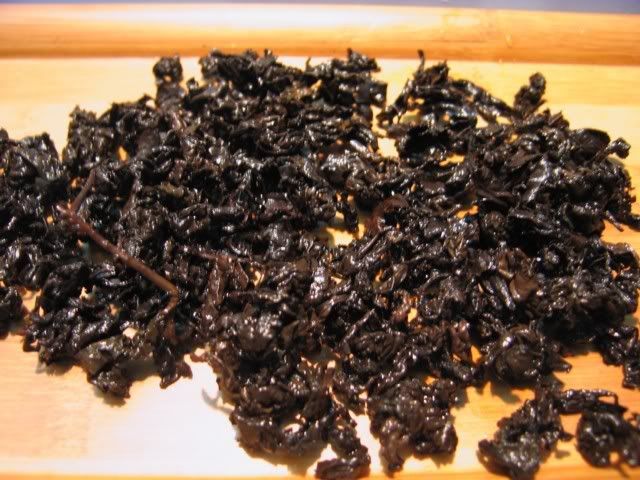Another sample from Will of the LA Tea Group

Sample A, it says. Dry leaves are tightly rolled, highly roasted oolong of some sort or another. Based on the look of the leaves, I’m going to guess Taiwanese oolong of some sort.

The tea tastes more or less like other very highly roasted teas I’ve had in the past — somewhat sweet, very roasty, with a bit of bitterness coming from the roasting or perhaps the tea itself. It’s so roasted that you can’t really tell what the tea’s original character may or may not have been — it’s just very roasty. No sourness though, which is nice.

Leaves are very stiff — not much to look at here. Most of them have barely unfurled after being exhausted by me, and that means a few hours of steeping.
This is, again, stuff that is often sold as aged oolong of some sort or another, priced variously from quite reasonable to extremely expensive. I think I’ve said this sort of tea is like cooked puerh (or heavily wet stored ones) — “aged” through an artificial process that approximates an aged tea, but does not really end up resembling the real McCoy. Then again, maybe this is just sold as highly roasted oolong, which is fine.

7 responses so far ↓
lewperin // March 17, 2008 at 2:56 pm |
I know you haven’t exactly said cooked Pu’er inevitably has stiff leaves. But it’s an idea I once assumed. And lately, as I’ve been sampling lots of different cooked Pu’ers (thanks to a friend who may well be lurking here), I’ve come across stiff ones and supple ones. And I can’t honestly say the supple ones have been notably better than the stiff ones on the whole. I know stiffness is ugly; it’s, well, dead. But right now I keep it in the heap on my desk marked “Tea Variables – To Be Filed Later”.
Anonymous // March 17, 2008 at 2:57 pm |
Sample A is an alleged 10 year aged Anxi roasted TGY from a store at Tianshan mall. I sent it along mostly because I thought you’d be interested to get such a heavily roasted tea from Tianshan. I 100% agree that it’s probably not aged very much (if at all). Also, it’s a little flat / 1 dimensional (even the woman brewing it said that she would keep brewing it, but that it would keep tasting the same). On the flip side, it’s consistent. Sometimes I like this one, and sometimes I’m not so into it.
It cost me something like 250 RMB / half jin. They were asking maybe twice that, but since I didn’t think it was really aged, I didn’t want to pay more than that. Even so, it’s hard to tell whether the leaf is good quality or whether it has even any age at all on it, so it’s possible that I still got ripped off.
They had to especially go and get the two high fire teas they brewed for me (they were in very large foil bags) – either from the woman’s sister’s shop, or from their storage.
Sometimes it makes my throat a little sore after drinking it; I like the taste Ok when I’m in the right sort of mood, though.
MarshalN // March 17, 2008 at 3:13 pm |
Lew: No, stiff doesn’t necessarily mean bad, although in the case of oolongs, stiff, highly roasted generally means flat and somewhat boring — you’re not going to get a lot out of the tea other than some consistent roasty note.
Will: Thanks for letting me know what this is :). My guess is this might’ve indeed been aged, but aged badly, thus requiring a long roast in order to make it saleable again. The roasting couldn’t have happened long time ago, as the roating taste is still quite obvious. I’m not surprised though that they had to fetch it for you though, because chances are nobody in Shanghai wants stuff like this. 250RMB/half jin isn’t too bad a price to pay for this.
jashnew1 // March 17, 2008 at 3:34 pm |
Marshall- Big fan. Read it everyday. I was the one who asked you 2 months ago about your thoughts on Hao Bin Ren. I was looking through the most recent Upton Tea catalog and they stated in their opening letter to their buyers that all their high grade Yunnan teas are sold out due to high demand. I was blown away. It seems odd to me. I wanted to get your take on this. Do you have any info on a shortage of high grade Yunnan tea.
MarshalN // March 17, 2008 at 4:26 pm |
Hey there
high grade Yunnan tea? Probably all used up to make puerh of all forms, good and bad. The farmers and the first line producers of raw tea (i.e. not yet processed leaves) make more money selling to puerh makers than to people who make Yunnan black… so why make Yunnan black?
jashnew1 // March 17, 2008 at 4:46 pm |
Marshal- Thanks for getting back to me. I think Americans drink more Yunnan Golden type tea than pu-erh. I like your theory. I guess I didn’t realize how popular pu-erh is. I’m not a fan. Maybe I haven’t found a good place to get it. Do you have a reccomendations for a good pu-erh website.
Anonymous // March 19, 2008 at 3:15 pm |
The taste really doesn’t have the added dimension that even a highly roasted aged tea tends to have in my (admittedly limited) experience. It’s possible that the tea is aged, but it really doesn’t taste that way to me – it tastes more like a roasted tea. I have had some extremely roasted teas where that richness and flavor that I tend to associate with aging is more present.
Of course it’s impossible to know for sure. My gut feeling (especially because this style of tea is not popular at all in Shanghai) is that this is the company’s way of selling off the stale fresh TGY that they can’t sell. I’ve got a fair amount of this left, so my plan is to let it sit for a few years and see if the roasty flavor mellows even more.